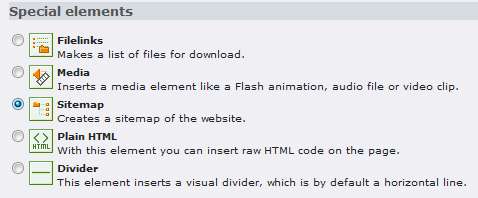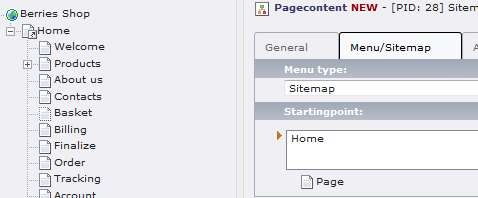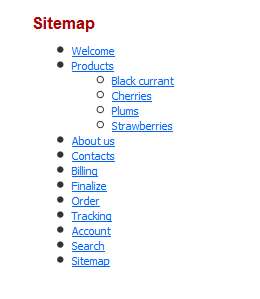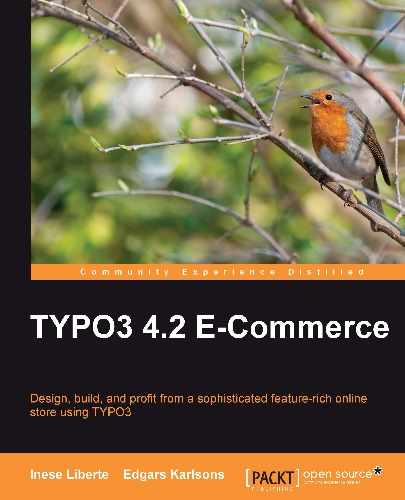We can adjust the name Sitemap for two different but similar meaning elements of the web page. Sitemap is the site map of your website, with a chronological layout of the pages. This is a good way to help visitors understand the structure of your website. Also, Sitemap is in the XML format, where information about pages, page updates, and importance of pages is stored. The XML format site map is for search bots—for example Google or Yahoo! More detailed information about XML site map can be found inChapter 9, where we describe SEO importance and requirements.
You can create a site map of your website and add this element to your online shop. Search bots will be able to find the sitemap and make a reference to your website.
Sitemap is available as a content element. You haven't set up any extra extensions for use as a site map element. For creating and adding Sitemap to your website, from the BE left menu, choose the Page module and also the page where the site map will be added. Press on Create page content and you can choose the new special element for your page content. In our example it is Sitemap, as you can see in the following image:

Add the necessary information in the offered form fields—for example, the title for this content element. Then, in the tab Sitemap/Menu choose:
- Menu type—Sitemap—as you see in the tab title, you can choose whether it will be an extra menu that is added like a content element.
- Startingpoint—point from where the page structure will be overseen.

Save the added content element and click on the page where the site map was created. Call out the context menu and choose to oversee the page. The site map structure will be created using unsorted list tags (<ul>,<li> tags).

Often, there can be a situation where for menus in your website you will need more than one level. If you don't want to divide the menu into two separate menus (for example, top menu for pages and left menu for subpages), you can create a multi-level menu.
For search bots, it is better that you use unsorted list tags (with<ul> <li> tags) because they are quiet similar to site map:
MULTILEVELMENU = HMENU
MULTILEVELMENU {
### FIRST LEVEL PAGES
1 = TMENU
1.wrap = <ul class="first-level">|</ul>
1 {
NO {
wrapItemAndSub = <li>|</li>
}
ACT = 1
ACT {
wrapItemAndSub = <li class="first-level-sub active-link">|</li>
}
}
### SECOND LEVEL PAGES (SUBPAGES)
2 = TMENU
2.wrap = <ul class="second-level">|</ul>
2 {
NO {
wrapItemAndSub = <li>|</li>
}
ACT = 1
ACT {
wrapItemAndSub = <li class="second-level-sub active-link">|</li>
}
}
}
In this example, we outputted the menu with two levels. If you need extra levels, you can add them using a part of the "SECOND LEVEL PAGES", as you can see in the code example below:
### SECOND LEVEL PAGES (SUBPAGES)
3 = TMENU
3.wrap = <ul class="third-level">|</ul>
3 {
NO {
wrapItemAndSub = <li>|</li>
}
ACT = 1
ACT {
wrapItemAndSub = <li class="third-level-sub active-link">|</li>
}
}
}
Usually, you can add submenus until the fourth level. But, you should remember that submenus are for page navigation improvement. You website menu levels should be friendly to online shop visitors.
